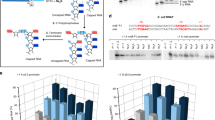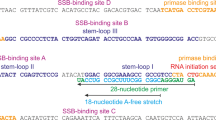Abstract
VERY little is known about the natural function of the peptide antibiotics. The production of antibiotics may be related to sporulation as only sporulating microorganisms produce antibiotics1. In general, the synthesis of antibiotics occurs within a limited time at the end of the logarithmic growth of cell cultures2, concurrent with a change in the specificity of transcription3. Loss, through mutation, of the ability to synthesise the antibiotic leads to asporogeny, in some cases1. Specific inhibitors and changes in culture conditions affect both the synthesis of antibiotic and sporulation4. Sarkar and Paulus5 demonstrated that the cyclic peptide antibiotic, tyrocidine, produced by Bacillus brevis (ATCC 8185) effects RNA synthesis in vivo, whereas DNA synthesis continues. Moreover, these authors give evidence that tyrocidine inhibited an in vitro RNA transcriptional system using B. brevis DNA and B. brevis DNA-dependent RNA polymerase. Complete inhibition of RNA synthesis with a tyrocidine concentration comparable to that in a B. brevis cell at the end of the vegetative growing phase was observed. A strong binding of the oligopeptide antibiotics, neotropsin and distamycin A, to double-stranded DNA, resulting in a pronounced heat stabilisation of the double-strands, has been reported6. Compared with pure DNA, these peptide-DNA complexes exhibit a low template activity7.
This is a preview of subscription content, access via your institution
Access options
Subscribe to this journal
Receive 51 print issues and online access
$199.00 per year
only $3.90 per issue
Buy this article
- Purchase on Springer Link
- Instant access to full article PDF
Prices may be subject to local taxes which are calculated during checkout
Similar content being viewed by others
References
Schaeffer, P., Bact. Rev., 33, 48 (1969).
Lipmann, F., Science, 173, 875 (1971).
Linn, T. G., Greenleaf, A. L., Shorenstein, R. G., and Losick, R., Proc. natn. Acad. Sci. U.S.A., 70, 1865 (1973).
Paulus, H., in Antibiotics (edit. by Gottlieb, D., and Shaw, P. D.), 2, 254 (Springer, Berlin, 1967).
Sarkar, N., and Paulus, H., Nature new Biol., 239, 228 (1972).
Zimmer, C., Reinert, K. E., Wähnert, U., Löber, G., and Thrum, H., J. molec. Biol., 58, 329 (1971).
Zimmer, C., Puschendorf, B., Grunicke, H., Chandra, P., and Venner, H., Eur. J. Biochem., 21, 269 (1971).
Burgess, R. R., J. biol. Chem., 244, 6160 (1969).
Sarkar, N., and Paulus, H., Proc. natn. Acad. Sci. U.S.A., 69, 3570 (1972).
Riggs, A. D., Suzuki, H., and Bourgeois, S., J. molec. Biol., 48, 67 (1970).
Yoshida, T., Weissbach, H., and Katz, E., Archs Biochem. Biophys., 114, 252 (1966).
Author information
Authors and Affiliations
Rights and permissions
About this article
Cite this article
SCHAZSCHNEIDER, B., RISTOW, H. & KLEINKAUF, H. Interaction between the antibiotic tyrocidine and DNA in vitro. Nature 249, 757–759 (1974). https://doi.org/10.1038/249757a0
Received:
Revised:
Issue Date:
DOI: https://doi.org/10.1038/249757a0
This article is cited by
Comments
By submitting a comment you agree to abide by our Terms and Community Guidelines. If you find something abusive or that does not comply with our terms or guidelines please flag it as inappropriate.



